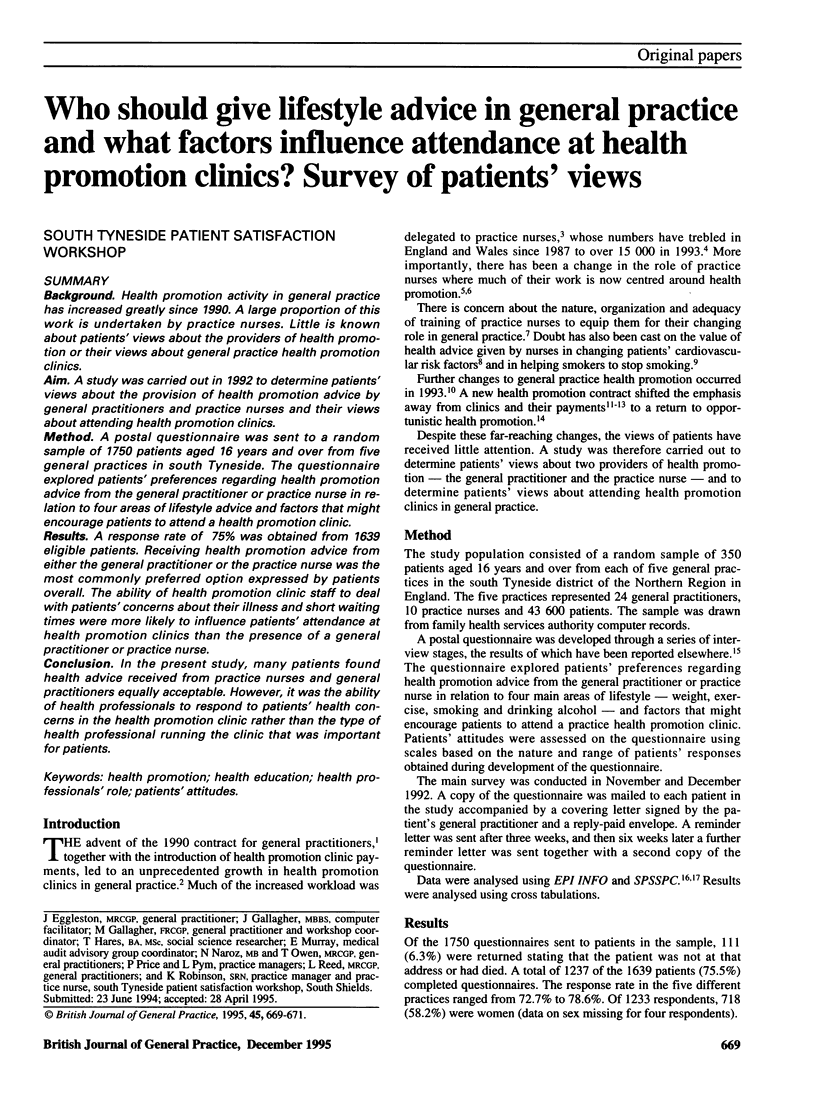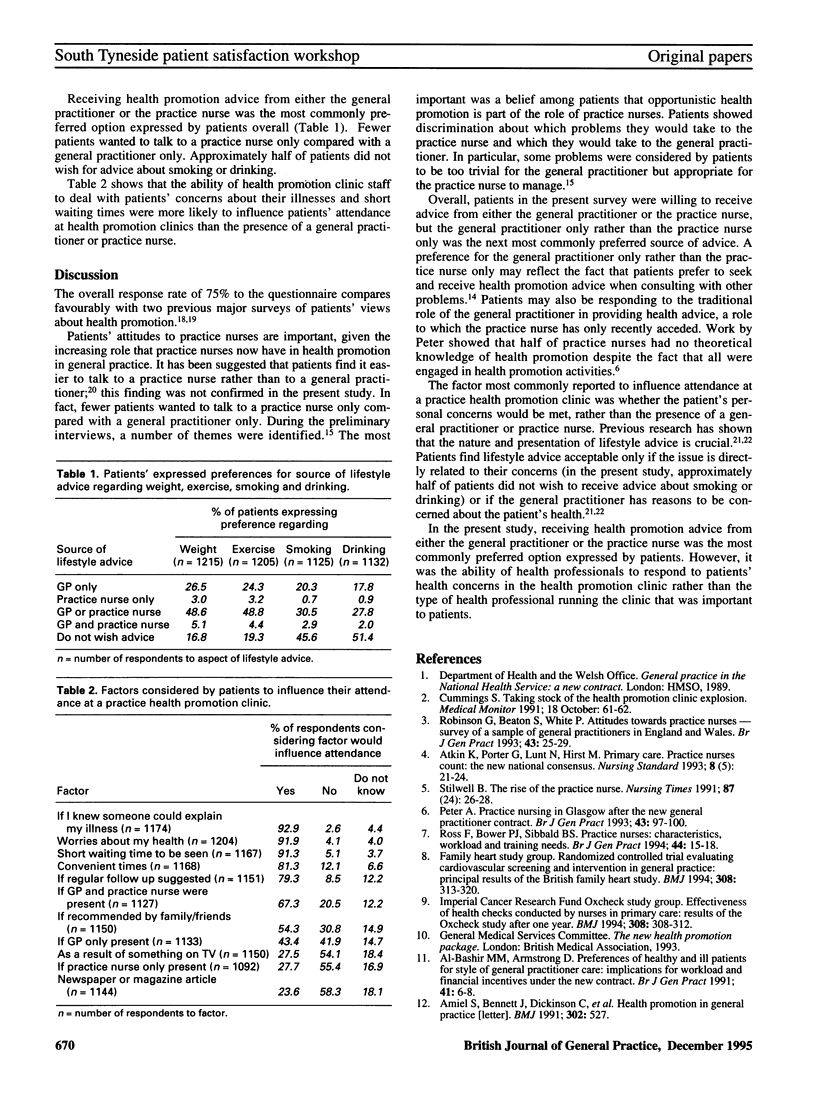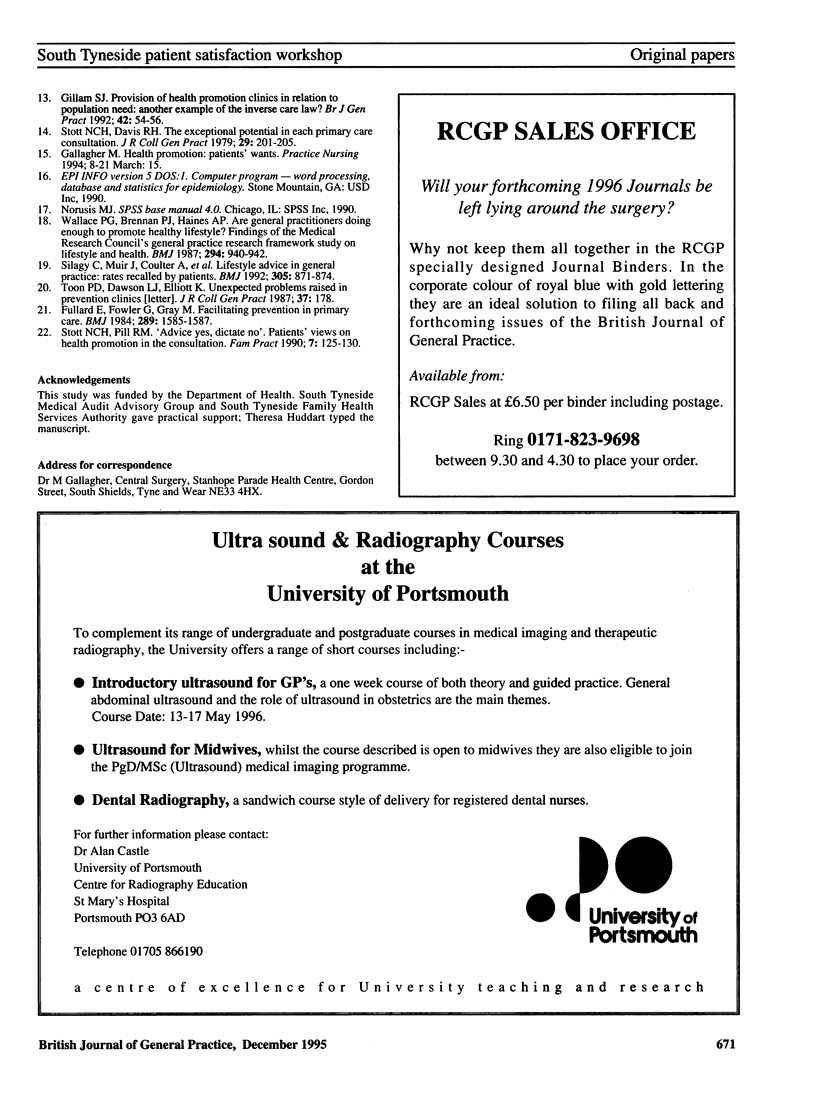Abstract
BACKGROUND: Health promotion activity in general practice has increased greatly since 1990. A large proportion of this work is undertaken by practice nurses. Little is known about patients' views about the providers of health promotion or their views about general practice health promotion clinics. AIM: A study was carried out in 1992 to determine patients' views about the provision of health promotion advice by general practitioners and practice nurses and their views about attending health promotion clinics. METHOD: A postal questionnaire was sent to a random sample of 1750 patients aged 16 years and over from five general practices in south Tyneside. The questionnaire explored patients' preferences regarding health promotion advice from the general practitioner or practice nurse in relation to four areas of lifestyle advice and factors that might encourage patients to attend a health promotion clinic. RESULTS: A response rate of 75% was obtained from 1639 eligible patients. Receiving health promotion advice from either the general practitioner or the practice nurse was the most commonly preferred option expressed by patients overall. The ability of health promotion clinic staff to deal with patients' concerns about their illness and short waiting times were more likely to influence patients' attendance at health promotion clinics than the presence of a general practitioner or practice nurse. CONCLUSION: In the present study, many patients found health advice received from practice nurses and general practitioners equally acceptable. However, it was the ability of health professionals to respond to patients' health concerns in the health promotion clinic rather than the type of health professional running the clinic that was important for patients.
Full text
PDF


Selected References
These references are in PubMed. This may not be the complete list of references from this article.
- Amiel S., Health I., Bennett J., Kelley D., Dickinson C., Miller R. Health promotion in general practice. BMJ. 1991 Mar 2;302(6775):527–527. doi: 10.1136/bmj.302.6775.527. [DOI] [PMC free article] [PubMed] [Google Scholar]
- Atkin K., Parker G., Lunt N., Hirst M. Primary care. Practice nurses count: the new national census. Nurs Stand. 1993 Oct 20;8(5):21–24. doi: 10.7748/ns.8.5.21.s42. [DOI] [PubMed] [Google Scholar]
- Fullard E., Fowler G., Gray M. Facilitating prevention in primary care. Br Med J (Clin Res Ed) 1984 Dec 8;289(6458):1585–1587. doi: 10.1136/bmj.289.6458.1585. [DOI] [PMC free article] [PubMed] [Google Scholar]
- Gillam S. J. Provision of health promotion clinics in relation to population need: another example of the inverse care law? Br J Gen Pract. 1992 Feb;42(355):54–56. [PMC free article] [PubMed] [Google Scholar]
- Peter A. Practice nursing in Glasgow after the new general practitioner contract. Br J Gen Pract. 1993 Mar;43(368):97–100. [PMC free article] [PubMed] [Google Scholar]
- Robinson G., Beaton S., White P. Attitudes towards practice nurses--survey of a sample of general practitioners in England and Wales. Br J Gen Pract. 1993 Jan;43(366):25–29. [PMC free article] [PubMed] [Google Scholar]
- Ross F. M., Bower P. J., Sibbald B. S. Practice nurses: characteristics, workload and training needs. Br J Gen Pract. 1994 Jan;44(378):15–18. [PMC free article] [PubMed] [Google Scholar]
- Silagy C., Muir J., Coulter A., Thorogood M., Yudkin P., Roe L. Lifestyle advice in general practice: rates recalled by patients. BMJ. 1992 Oct 10;305(6858):871–874. doi: 10.1136/bmj.305.6858.871. [DOI] [PMC free article] [PubMed] [Google Scholar]
- Stilwell B. The rise of the practice nurse. Nurs Times. 1991 Jun 12;87(24):26–28. [PubMed] [Google Scholar]
- Stott N. C., Davis R. H. The exceptional potential in each primary care consultation. J R Coll Gen Pract. 1979 Apr;29(201):201–205. [PMC free article] [PubMed] [Google Scholar]
- Stott N. C., Pill R. M. 'Advise yes, dictate no'. Patients' views on health promotion in the consultation. Fam Pract. 1990 Jun;7(2):125–131. doi: 10.1093/fampra/7.2.125. [DOI] [PubMed] [Google Scholar]
- Toon P. D., Dawson L. J., Elliott K. Unexpected problems raised in prevention clinics. J R Coll Gen Pract. 1987 Apr;37(297):178–178. [PMC free article] [PubMed] [Google Scholar]
- Wallace P. G., Brennan P. J., Haines A. P. Are general practitioners doing enough to promote healthy lifestyle? Findings of the Medical Research Council's general practice research framework study on lifestyle and health. Br Med J (Clin Res Ed) 1987 Apr 11;294(6577):940–942. doi: 10.1136/bmj.294.6577.940. [DOI] [PMC free article] [PubMed] [Google Scholar]
- al-Bashir M. M., Armstrong D. Preferences of healthy and ill patients for style of general practitioner care: implications for workload and financial incentives under the new contract. Br J Gen Pract. 1991 Jan;41(342):6–8. [PMC free article] [PubMed] [Google Scholar]


